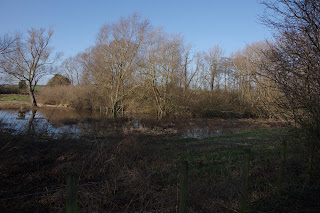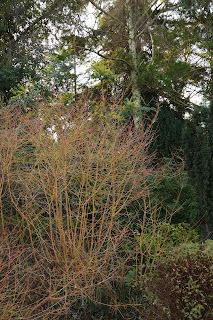Winter Aconites (Eranthis hyemalis) on a grey morning. The flower heads open wide when the sun is on them but remain closed on dull days...
A diary of back garden botany, urban ecology, rural rambles and field trips to the middle of nowhere...
Wednesday 31 January 2024
Thursday 25 January 2024
Sunday 21 January 2024
Thursday 18 January 2024
We have had a wet winter, by which I mean considerably wetter than average. This woodland is a stone's throw from Wellhead where the River Hiz rises, one of a number of chalk streams in Hertfordshire that converge and merge en route to the Wash.
Typically it is rather swampy. Beyond is a millpond where a waterwheel was recorded as far back as the Domesday Book. Indeed the wood appears to have grown in a section of the millpond that became silted up over time.
A few decades ago a borehole/pumping station was built right next to it. From that point on the wood dried out to a muddy sump for much of the year. When we have prolonged rain in the winter months the waters rise. Generally this only floods the wood but some years (like this year) large areas of the the surrounding fields are submerged as well. That is my measure of how wet a winter has been.
Tuesday 16 January 2024
Even January has its wildflowers, notably the Stinking Hellebore (Helleborus foetidus) which can be found in woodland glades, hedge banks and scrub. Self-seeds readily in some locations with a marked preference for calcareous soils.
H. foetidus is a native species that is also cultivated in a good many gardens. As such it is both a wildflower and a naturalised garden escape; the distinction is moot I imagine.
Monday 15 January 2024
A rare sight: blossom in winter. I think this is Prunus x subhirtella which the Royal Horticultural Society lists as a naturally occurring hybrid from Japan. A cultivar named 'Autumnalis' is available from suppliers in the horticultural trade, one notes that it was introduced to the UK in 1894. Presumably that's what we're looking at here.
Most cherries flower in spring but Prunus x subhirtella is aptly known as the Winter Flowering Cherry.
Saturday 13 January 2024
Wednesday 10 January 2024
Frosty morning. The garden at the music school still looks great in a wintery sort of a way. The seed heads of the Sedums are dusted with ice. The Hellebores are in full flower; like many winter hardy plants they flop in freezing conditions and will rise again when it's warmer.
Dogwoods are a stalwart of the winter garden (i.e. Cornus species and cultivars). Nice and leafy in summer the bare stems are an ornamental feature in their own right and generally planted for that reason.
In the rock garden Primroses are stirring despite the sub-zero temperatures.
Saturday 6 January 2024
Tuesday 2 January 2024
A Blue Tit eyeing up the sunflower seeds (just to the left of the feeder). Nervous birds they like to dart in from the cover of surrounding branches then dart out after a quick peck. Sunflower hearts seem to be a particular favourite among a variety of birds.
Back in the days when milk was delivered in glass bottles on doorsteps it was Blue Tits who pecked through the Gold and Silver tops to get at the cream. That is a rather remarkable example of a species adapting to the modern world. They learned how to do something not just individually but as a population.
Subscribe to:
Posts (Atom)



















